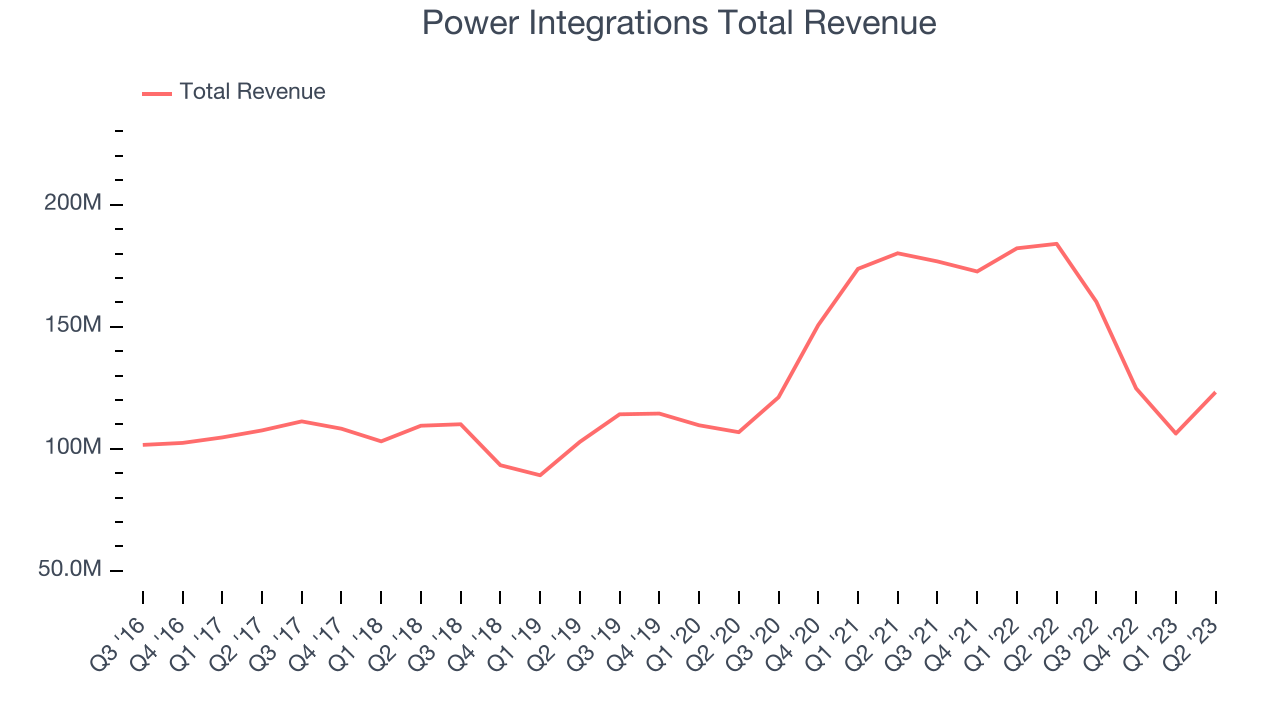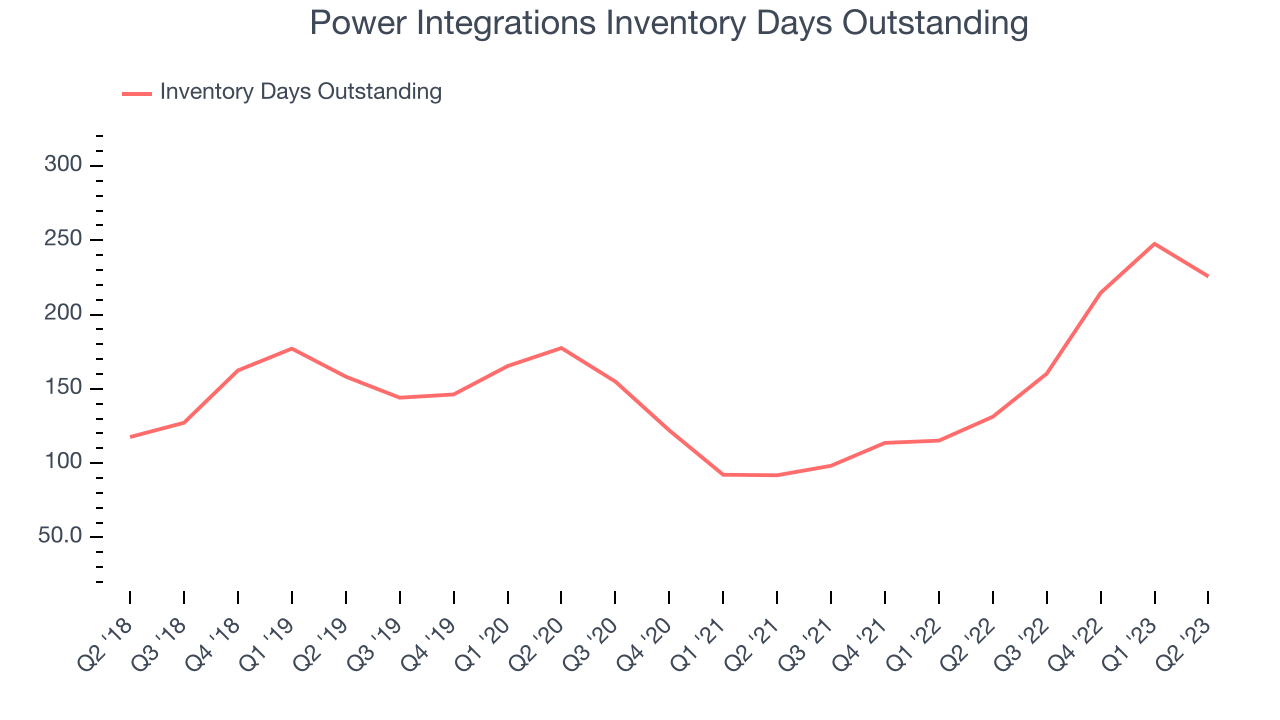Semiconductor designer Power Integrations (NASDAQ:POWI) reported results in line with analysts' expectations in Q2 FY2023, with revenue down 33% year on year to $123.2 million. However, next quarter's revenue guidance of $130 million was less impressive, coming in 13.3% below analysts' estimates. Power Integrations made a GAAP profit of $14.8 million, down from its profit of $55.8 million in the same quarter last year.
Is now the time to buy Power Integrations? Find out by accessing our full research report free of charge.
Power Integrations (POWI) Q2 FY2023 Highlights:
- Revenue: $123.2 million vs analyst estimates of $122.4 million (small beat)
- EPS (non-GAAP): $0.36 vs analyst estimates of $0.34 (6.4% beat)
- Revenue Guidance for Q3 2023 is $130 million at the midpoint, below analyst estimates of $149.9 million
- Free Cash Flow of $3.05 million, down 75.6% from the previous quarter
- Inventory Days Outstanding: 226, down from 248 in the previous quarter
- Gross Margin (GAAP): 51%, down from 58.1% in the same quarter last year
A leading supplier of parts for electronics such as home appliances, Power Integrations (NASDAQ:POWI) is a semiconductor designer and developer specializing in products used for high-voltage power conversion.
Demand for analog chips is generally linked to the overall level of economic growth, as analog chips serve as the building blocks of most electronic goods and equipment. Unlike digital chip designers, analog chip makers tend to produce the majority of their own chips, as analog chip production does not require expensive leading edge nodes. Less dependent on major secular growth drivers, analog product cycles are much longer, often 5-7 years.
Sales Growth
Power Integrations's revenue growth over the last three years has been unremarkable, averaging 10% annually. This quarter, its revenue declined from $184 million in the same quarter last year to $123.2 million. Semiconductors are a cyclical industry, and long-term investors should be prepared for periods of high growth followed by periods of revenue contractions (which can sometimes offer opportune times to buy).

Even though Power Integrations surpassed analysts' revenue estimates, this was a slow quarter for the company as its revenue dropped 33% year on year. This could mean that the current downcycle is deepening.
Power Integrations may be headed for an upturn. Although the company is guiding for a year-on-year revenue decline of 18.9% next quarter, analysts are expecting revenue to grow 28.1% over the next 12 months.
While most things went back to how they were before the pandemic, a few consumer habits fundamentally changed. One founder-led company is benefiting massively from this shift and is set to beat the market for years to come. The business has grown astonishingly fast, with 40%+ free cash flow margins, and its fundamentals are undoubtedly best-in-class. Still, its total addressable market is so big that the company has room to grow many times in size. You can find it on our platform for free.
Product Demand & Outstanding Inventory
Days Inventory Outstanding (DIO) is an important metric for chipmakers, as it reflects a business' capital intensity and the cyclical nature of semiconductor supply and demand. In a tight supply environment, inventories tend to be stable, allowing chipmakers to exert pricing power. Steadily increasing DIO can be a warning sign that demand is weak, and if inventories continue to rise, the company may have to downsize production.

This quarter, Power Integrations's DIO came in at 226, which is 74 days above its five-year average. These numbers suggest that despite the recent decrease, the company's inventory levels are higher than what we've seen in the past.
Key Takeaways from Power Integrations's Q2 Results
With a market capitalization of $5.23 billion, Power Integrations is among smaller companies, but its $346.3 million cash balance and positive free cash flow over the last 12 months give us confidence that it has the resources needed to pursue a high-growth business strategy.
We were impressed by Power Integrations's strong improvement in inventory levels. We were also excited that its earnings growth outperformed Wall Street's expectations. On the other hand, its underwhelming revenue guidance for next quarter was disappointing and its operating margin declined. Overall, the results could have been better. The stock is flat after reporting and currently trades at $90.01 per share.
Power Integrations may have had a tough quarter, but does that actually create an opportunity to invest right now? When making that decision, it's important to consider its valuation, business qualities, as well as what has happened in the latest quarter. We cover that in our actionable full research report which you can read here, it's free.
One way to find opportunities in the market is to watch for generational shifts in the economy. Almost every company is slowly finding itself becoming a technology company and facing cybersecurity risks and as a result, the demand for cloud-native cybersecurity is skyrocketing. This company is leading a massive technological shift in the industry and with revenue growth of 50% year on year and best-in-class SaaS metrics it should definitely be on your radar.
The author has no position in any of the stocks mentioned in this report.
